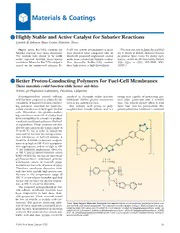
NASA Technical Reports Server (NTRS) 20120006559: Better Proton-Conducting Polymers for Fuel-Cell Membranes PDF
Preview NASA Technical Reports Server (NTRS) 20120006559: Better Proton-Conducting Polymers for Fuel-Cell Membranes
Materials & Coatings Highly Stable and Active Catalyst for Sabatier Reactions Lyndon B. Johnson Space Center, Houston, Texas Highly active Ru/TiO2 catalysts for CrAlY felt, activity enhancement is more This work was done by Jianli Hu and Kris- Sabatier reaction have been developed. than doubled when compared with an ton P. Brooks of Battelle Memorial Institute The catalysts have shown to be stable identically prepared engineered catalyst for Johnson Space Center. For further infor- under repeated shutting down/startup made from commercial Degussa catalyst. mation, contact the JSC Innovation Partner- conditions. When the Ru/TiO2catalyst is Also, bimetallic Ru-Rh/TiO2 catalysts ships Office at (281) 483-3809. MSC- coated on the engineered substrate Fe- show high activity at high throughput. 24299-1 Better Proton-Conducting Polymers for Fuel-Cell Membranes These materials could function while hotter and drier. NASA’s Jet Propulsion Laboratory, Pasadena, California Polyoxyphenylene triazole sulfonic attached to thermally stable polymer strong acid capable of generating pro- acid has been proposed as a basis for de- backbones exhibit proton conduction tons when presented with a suitable velopment of improved proton-conduct- even in the anhydrous state. base. The triazole moiety offers at least ing polymeric materials for solid-elec- The sulfonic acid group in poly- three base sites for protonation. The trolyte membranes in hydrogen/air fuel oxyphenylene triazole sulfonic acid is a polyoxyphenylene backbone is endowed cells. Heretofore, the proton-conduct- ing membrane materials of choice have been exemplified by a family of perfluo- rosulfonic acid-based polymers (Nafion7 or equivalent). These materials are suit- N N able for operation in the temperature of N 75 to 85 °C, but in order to reduce the sizes and/or increase the energy-conver- sion efficiencies of fuel-cell systems, it would be desirable to increase tempera- HOS O SO3H 3 tures to as high as 120 °C for transporta- tion applications, and to as high as 180 X N °C for stationary applications. However, N N at 120 °C and at relative humidity values n below 50 percent, the loss of water from perfluorosulfonic acid-based polymer 1: X = O membranes results in fuel-cell power 2: X = C(CH3)2 densities too low to be of practical value. Therefore, membrane electrolyte mate- O rials that have usefully high proton con- O S ductivity in the temperature range of O n 180 °C at low relative humidity and that do not rely on water for proton conduc- O tion at 180 °C would be desirable. N SOH The proposed polyoxyphenylene tria- m N 3 N zole sulfonic acid-based materials have 3 been conjectured to have these desir- able properties. These materials would be free of volatile or mobile acid con- stituents. The generic molecular struc- These Three Generic Molecular Structuresare representative of the proposed polyoxyphenylene tria- ture of these materials is intended to ex- zole sulfonic acid-based compounds. The subscripts mand ndenote integers. These compounds as de- ploit the fact, demonstrated in previous noted by their full names are (1) poly[(1H-1,2,3-triazole-1,4-diyl)-co-(oxyphenylenesulfonic acid)], (2) poly[(1H-1,2,3-triazole-1,4-diyl)-co-bisphenylenesulfonic acid)-co-(oxyphenylenesulfonic acid)], research, that materials that contain ion- and (3) poly[(oxyphenylenesulfone)-graft-1-(1H-1,2,3-triazole-1,4-diyl)-1-poly(ethylene oxide)-4- izable acid and base groups covalently benzenesulfonic acid)]. NASA Tech Briefs, January 2012 25 with excellent thermal stability, as evi- Above the boiling temperature of water, This work was done by Sri Narayan of Cal- denced by the numerous engineering membranes become dehydrated, but tech and Prakash Reddy of the University of polymers, incorporating this and related membranes made of the proposed mate- Missouri-Rola for NASA’s Jet Propulsion Labo- backbones, that can withstand operating rials could still conduct protons by trans- ratory. For more information, contact temperatures up to 300 °C. Also, poly- fer between the acid and base groups on [email protected]. mers that have similar backbones the polymer backbones. Hence, the pro- In accordance with Public Law 96-517, [poly(arylene ether ether ketone) and posed polymers are expected to conduct the contractor has elected to retain title to this poly(arylene ether sulfone)] have been protons under anhydrous as well as hy- invention. Inquiries concerning rights for its reported to be electrochemically stable. drous conditions. commercial use should be addressed to: Hence, the proposed polymers are ex- The figure depicts generic molecu- Innovative Technology Assets Management pected to exhibit high thermal and elec- lar structures of three types of com- JPL trochemical stability. pounds according to the proposal. Mail Stop 202-233 Below the boiling temperature of These compounds could be synthe- 4800 Oak Grove Drive water, the proposed materials could ab- sized from commercially available Pasadena, CA 91109-8099 sorb and retain water and could conduct starting compounds and/or from in- E-mail: [email protected] protons by means of the same physical termediate compounds that can be Refer to NPO-44760, volume and num- mechanisms as those of prior membrane synthesized from commercially avail- ber of this NASA Tech Briefs issue, and electrolyte materials that rely on water. able starting compounds. the page number. 26 NASA Tech Briefs, January 2012
